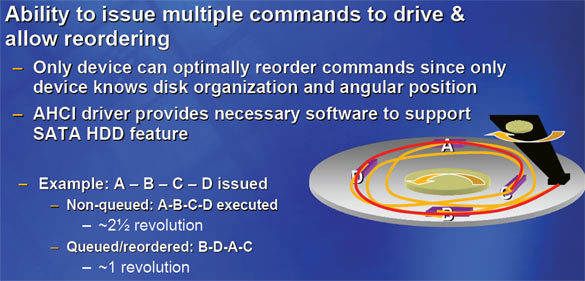Hitachi's 7K400 Hard Drive Capacity Reaches 400 GB, Maxtor's MaXLine III Advances Serial ATA
What Can Command Queuing Do?
This slide is part of an Intel presentation documenting the technical details of the 900 series chipsets.
Literally, command queuing means to put commands into a certain order - here, we're talking about the commands to a drive with which data is to be read or written. However, the deeper meaning of command queuing is to analyze these commands and changing the order of commands depending on the action that would ensue. The bottom line: wait times are reduced, as disc rotation and avoidable head movements are reduced. In the example cited above, reading the four sectors would take just one rotation of the storage discs, instead of 2.5. This means that the drive would be available sooner to receive new requests.
Command Queuing As Performance Booster
That said, command queuing is certainly no method to boost the absolute performance of a hard drive. The maximum transfer rates as well as the search and access times do not change. What does happen, though, is that the requirements for a multi-tasking or multi-threading environment are factored in. For example, you might launch a complex application while simultaneously burning a DVD, and in the meantime emails are pouring in. In such an instance, all applications and services simultaneously access the drive(s), meaning that optimizing accesses via command queuing can actually save a lot of wait time in everyday user operations.
You can find additional, in-depth information on Command Queuing in this document:
Get Tom's Hardware's best news and in-depth reviews, straight to your inbox.
Current page: What Can Command Queuing Do?
Prev Page Innovation, Finally Next Page Which Devices Offer Command Queuing?
Patrick Schmid was the editor-in-chief for Tom's Hardware from 2005 to 2006. He wrote numerous articles on a wide range of hardware topics, including storage, CPUs, and system builds.
